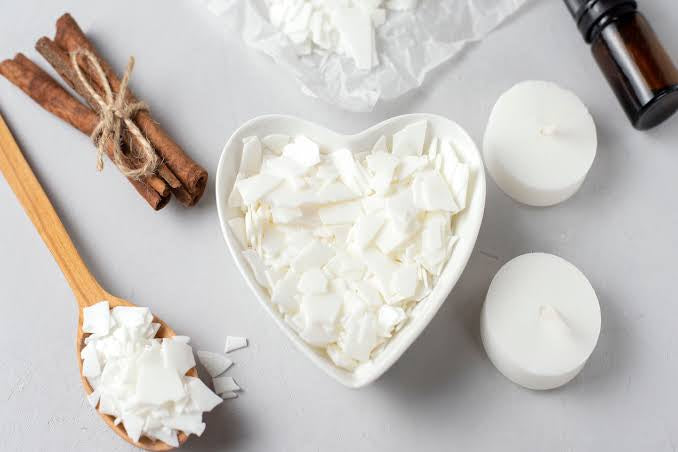The Art and Science of Candle Making:
A Comprehensive Look at Different Waxes
Candle making is not just an art; it's a fascinating interplay of chemistry, tradition, and creativity. At the heart of this craft lies a selection of waxes, each with unique properties that can affect everything from burning time to scent throw. This blog will delve into the various types of waxes used in candle making, highlighting their characteristics, advantages, and applications.
1. Paraffin Wax 🚫
Paraffin wax is one of the most commonly used waxes in the candle industry. It is a byproduct of petroleum refining and is known for its affordability and versatility.
Melting Point: Typically between 46°C to 68°C
- **Burn Characteristics**: Excellent scent throw.
- **Color**: Naturally white but can be dyed easily.
**Advantages**:
- **Cost-Effective**: One of the cheapest wax options available.
- **Availability**: Widely accessible and used in many commercial candles.
- **Scent Throw**: Excellent for holding and releasing fragrance.
**Disadvantages**:
- **Environmental Concerns**: As a petroleum product, it raises sustainability issues.
- **Chemical Additives**: Often contains additives that may not be desirable for all candle makers.
**Applications**: Commonly used in container candles, pillar candles, and tealights.
#### 2. Soy Wax
**Overview**: Soy wax has gained popularity as a natural alternative to paraffin. Made from soybeans, it is renewable and biodegradable.
**Properties**:
- **Melting Point**: Generally between 49°C to 82°C (120°F to 180°F).
- **Burn Characteristics**: Burns slower than paraffin, resulting in a longer-lasting candle.
- **Color**: Creamy white with a smooth texture.
**Advantages**:
- **Eco-Friendly**: Biodegradable and renewable, appealing to environmentally conscious consumers.
- **Clean Burn**: Produces less soot compared to paraffin.
- **Excellent Scent Throw**: Good for both hot and cold scent throw.
**Disadvantages**:
- **Cost**: Typically more expensive than paraffin.
- **Appearance**: Can develop frosting or uneven surfaces, which some may find unattractive.
**Applications**: Often used in container candles and votives, especially in eco-conscious markets.
#### 3. Beeswax
**Overview**: Beeswax is a natural wax produced by honeybees. It is one of the oldest known waxes and is prized for its natural properties.
**Properties**:
- **Melting Point**: Approximately 62°C to 65°C (144°F to 149°F).
- **Burn Characteristics**: Burns very slowly and cleanly, with a natural honey scent.
- **Color**: Ranges from golden yellow to light brown, depending on the processing.
**Advantages**:
- **Natural and Non-Toxic**: Free from synthetic additives.
- **Air Purifying**: Emits negative ions when burned, which can purify the air.
- **Long Burn Time**: Known for its longevity and efficiency.
**Disadvantages**:
- **Cost**: Generally more expensive due to its natural sourcing.
- **Scent**: The natural honey scent may not blend well with all fragrances.
**Applications**: Suitable for pillar candles, rolled candles, and decorative candles.
#### 4. Palm Wax
**Overview**: Derived from palm oil, palm wax is another natural option that has gained traction in recent years.
**Properties**:
- **Melting Point**: Typically between 50°C to 70°C (122°F to 158°F).
- **Burn Characteristics**: Burns cleanly with a unique crystalline appearance.
- **Color**: Usually a creamy white or off-white.
**Advantages**:
- **Eco-Friendly**: If sourced sustainably, it can be a more environmentally friendly option.
- **Unique Texture**: Can create beautiful patterns and textures when cooled.
**Disadvantages**:
- **Sustainability Concerns**: Palm oil production can lead to deforestation and habitat loss if not sourced responsibly.
- **Fragrance Throw**: May not hold scent as effectively as soy or paraffin.
**Applications**: Great for decorative candles and those looking for a unique aesthetic.
#### 5. Coconut Wax
**Overview**: A newer entrant in the candle-making world, coconut wax is derived from the meat of coconuts.
**Properties**:
- **Melting Point**: Generally around 36°C to 45°C (97°F to 113°F).
- **Burn Characteristics**: Burns slowly and evenly with a creamy texture.
- **Color**: Typically white and smooth.
**Advantages**:
- **Sustainable**: Sourced from renewable coconut trees.
- **Great Scent Throw**: Excellent for scent retention and distribution.
- **Clean Burn**: Similar to soy, it produces minimal soot.
**Disadvantages**:
- **Cost**: Can be more expensive than traditional waxes.
- **Blending**: Often blended with other waxes for better performance.
**Applications**: Ideal for luxury candles and those seeking a clean, sustainable option.
### Conclusion
The choice of wax in candle making significantly impacts the final product. From the traditional paraffin wax to the eco-friendly options like soy and coconut wax, each type of wax has its unique qualities that cater to various preferences and needs. Understanding these differences allows candle makers to choose the right wax that aligns with their values, aesthetics, and desired outcomes in their creations. Whether for personal use or commercial production, the perfect wax is out there, waiting to be transformed into beautiful, aromatic candles.
Here's a simplified table summarizing the melting temperatures of different waxes used in candle making:
| **Wax Type** | **Melting Point (°C)** | **Melting Point (°F)** |
|------------------|------------------------|------------------------|
| Paraffin Wax | 46 - 68 | 115 - 154 |
| Soy Wax | 49 - 82 | 120 - 180 |
| Beeswax | 62 - 65 | 144 - 149 |
| Palm Wax | 50 - 70 | 122 - 158 |
| Coconut Wax | 36 - 45 | 97 - 113 |
This table provides a quick reference for the melting points of various wax types used in candle making.


Leave a comment